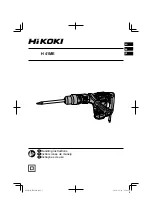
Test & Calibration Procedure
Important Electrical Safety Considerations
A substantial proportion of the power supply main PCB is occupied by primary side circuitry
comprising tracks, terminals and components (including one of the large heat sinks) which
normally operate at AC mains potential.
The incoming AC supply to the PCB or PSU under test must be isolated by means of a 1:1
isolation transformer of at least 700VA rating for safety and noise control.
High voltages (up to 400V peak) are always present in the primary side circuitry. Note that
removing bridging connector PJ4 disconnects HV only from the power FETs.
Components at high voltage lie within a well defined area of the main PCB which includes the
large heat sink SK1. The operator should familiarise himself with the boundaries of this area and
avoid contact within it.
Primary side earthing
- Earthing of the Y filter capacitor at GND3, at the hex spacer, is desirable
to control noise effects.
HV Capacitor Discharging
- Allow 6 mins for HV reservoirs C9,10 to discharge from 400V to
40V via R5,6. Alternatively discharge both capacitors with 100R 5W resistor.
Temporary Earthing for Primary Side Measurements
Voltage checks and CRO measurements on the main PCB primary side circuit are only carried
out with 60 VDC maximum applied to the switching power FETs. Primary side node VRECT-
must be well grounded (e.g. at Q1,2 mount bolts) to protect the user and the external PSU during
these measurements. Not that this negates the protection normally provided by the isolation
transformer and earths the particularly easily touched heat sink SK1.
Order of Checks and Adjustments
The power supplies comprise a switchmode pre-regulator operating at mains (primary) potential
which feeds a (secondary) linear regulator. The latter must be working properly for proper
operation or testing of the former. Both regulators obtain their auxiliary supplies from 50Hz
auxiliary transformer T1 the primary of which is fed from the mains potential (primary) section of
the PCB which is therefore energised during all tests. The order of checks and adjustments
reflects these dependencies and should be followed after any repair work.
Directions for Different Types
The directions are written as far as possible to cover normal (non-programmable) and
programmable versions. Settings and other values which vary between 35V/10A and 18V/20A
versions are respectively separated by an oblique stroke.
Figures referred to in the text appear on a fold-out sheet immediately before the Circuit Diagrams.
Test Equipment required for Recalibration only
Rheostat or other high power load arrangements to provide 3.5 & 2.75/0.9 & 0.6
Ω
at 10/20A for
35V/10A and 18V/20A respectively at 400W dissipation.
10
Ω
10W wirewound resistance.
Common mode rejection test network according to Fig 3.
Digital voltmeter with 100uV resolution and 1mV accuracy.
Current meter 20A maximum, 2mA accuracy, or equivalent shunt and voltmeter arrangement.
15
Содержание TSX Series
Страница 1: ...TSX Series High Current Power Supplies Service Manual Book Part Number 48511 0240 Issue 2...
Страница 6: ...5...
Страница 39: ...Circuit Diagrams 38...
Страница 40: ......
Страница 41: ......
Страница 42: ......
Страница 43: ......
Страница 44: ......
Страница 45: ......
Страница 46: ......
Страница 47: ......
Страница 48: ......
















































